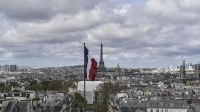Pan Wu, 26, originally from China and a graduate student in theoretical chemistry at Duke University in Raleigh, N.C., works at the university on May 31, 2013. Chinese Americans are represented at both ends of the economic spectrum, although when people think of Chinese immigrants they tend to think of the highly skilled and educated who arrive – the entrepreneurs, professionals, scientists and students like Wu.
Once singled out for exclusion by law from the United States, Chinese immigrants now make up the largest single group of arrivals a year into this country.
A recent report by the Census Bureau reported that China replaced Mexico as the top country of origin for immigrants to the U.S. in 2013, and another report has found that China sends more students to the U.S. than any other country.
What’s equally improbable, given the history, is that Chinese immigrants are now considered part of the rising Asian American “model minority,” showcasing how immigrants (and other minorities) can make it in America. Media portrayals of Chinese and other Asian Americans often contrast sharply to those of other immigrants, like undocumented immigrants from Mexico, or Middle Eastern Muslim immigrants unfairly tainted by association with terrorism.
Indeed, a closer look at Chinese immigration in the past and present shows not only how much public attitudes have changed in the last century, but also how fickle such shifts in attitudes can prove.
Although many of today’s Chinese immigrants are graduate students and wealthy investors, Chinese immigration has a long history in the United States. Many of the earlier immigrants were considered the lowest of the low-skilled workers coming to America.
Chinese sailors were among the crew on a ship that arrived in Baltimore in 1784. Chinese immigrants were living in New York City as early as the 1830s. And Chinese were among the thousands of gold seekers who rushed into California during the Gold Rush in the mid-19th century.
By 1870, there were 64,000 Chinese in the United States, most of them in California, and almost all of them from the Pearl River Delta region outside of Canton (Guangzhou) in southern China. They were indispensable laborers who helped to build the nation’s first transcontinental railroad as well as farm workers who turned California into the agricultural empire that it is today.
But Chinese immigrants also faced a tremendous amount of hostility.
The Chinese were labeled undesirable and impossible to assimilate. They were charged with taking away jobs, corrupting white women, and threatening American civilization. Chinese were harassed, beaten and driven out of small towns and big cities throughout the American West.
A regional movement to exclude Chinese immigrants turned into a national one. The rallying cry of “The Chinese Must Go!” came to be heard on the sandlots of San Francisco as well as in the halls of Congress.
In 1882, the U.S. passed the Chinese Exclusion Act, which barred Chinese laborers, prohibited all Chinese immigrants from becoming naturalized citizens, and allowed only select classes of Chinese to apply for admission. The Chinese Exclusion Act was the country’s first immigration law that singled out an immigrant group for large-scale exclusion based on race. And it led to wide-scale discrimination in U.S. immigration policy that resulted in the exclusion of almost all Asians before World War II.
While the act was in effect – from 1882 to 1943 – Chinese immigrants became America’s first illegal immigrants. Chinese immigration drastically dropped, though it never totally stopped. Many of those who did continue to come resorted to false papers (like my own grandfather), fraudulent identities, and even long and dangerous routes across the U.S.-Mexico border.
We know that those who arrived in San Francisco in those years faced harsh interrogations, humiliating medical examinations, and long detentions in the crowded and unsanitary barracks on Angel Island – arguably the nation’s first immigrant detention center, located in the middle of San Francisco Bay.
The hundreds of poems that Chinese immigrant detainees left behind on the barrack walls on Angel Island are testament to their anger, frustration and hardship, but also their perseverance and hope.
In the past 50 years, Chinese immigration has undergone a dramatic transformation. The landmark 1965 Immigration Act ended national origin quotas that favored immigration from Europe over other parts of the world and established preferences for professional and skilled workers.
At the same time, China’s subsequent economic modernization and new global outlook have revived and diversified the flow of immigration from China.
From 1960 to 1990, the Chinese population in the U.S. nearly doubled every decade. In 1960, there were just under 100,000 Chinese-born immigrants in the United States. In 2010, the Census reported more than 3.3 million adult Chinese Americans. Making up the largest group of Asian Americans and the largest ethnic Chinese population (including Taiwanese) outside of Asia, Chinese Americans represent 24 percent of the nation’s adult Asian population.
Chinese Americans are represented at both ends of the economic spectrum. But when people think of Chinese immigrants they tend to think of the highly skilled and educated who arrive – the entrepreneurs, professionals, scientists and students.
Indeed, in 2010 Chinese Americans had higher median annual personal earnings than the general U.S. population.
Chinese immigrants may not be scrutinized and debated in the same way that undocumented low-skilled Mexican immigrants crossing the border are these days, especially in Washington, but it would be a mistake to assume that America has fully embraced Chinese and other Asian immigrants.
Their growing numbers, economic power, and presence have already raised concerns and anxiety. Some Americans resent having to go to a doctor who has a foreign accent, for example, or having their kids compete with talented foreign-born (and even second-generation Asian American) students for spots in college or in the workplace.
There could be even more resentment if China’s national wealth and strength becomes more pronounced globally, and more explicitly opposed to American interests.
Erika Lee is a historian, writer and director of the Immigration History Research Center at the University of Minnesota. Her book, “The Making of Asian America: A History” will be published in September. She wrote this for What It Means to Be American a national conversation hosted by the Smithsonian and Zocalo Public Square.
Source: OC Register









